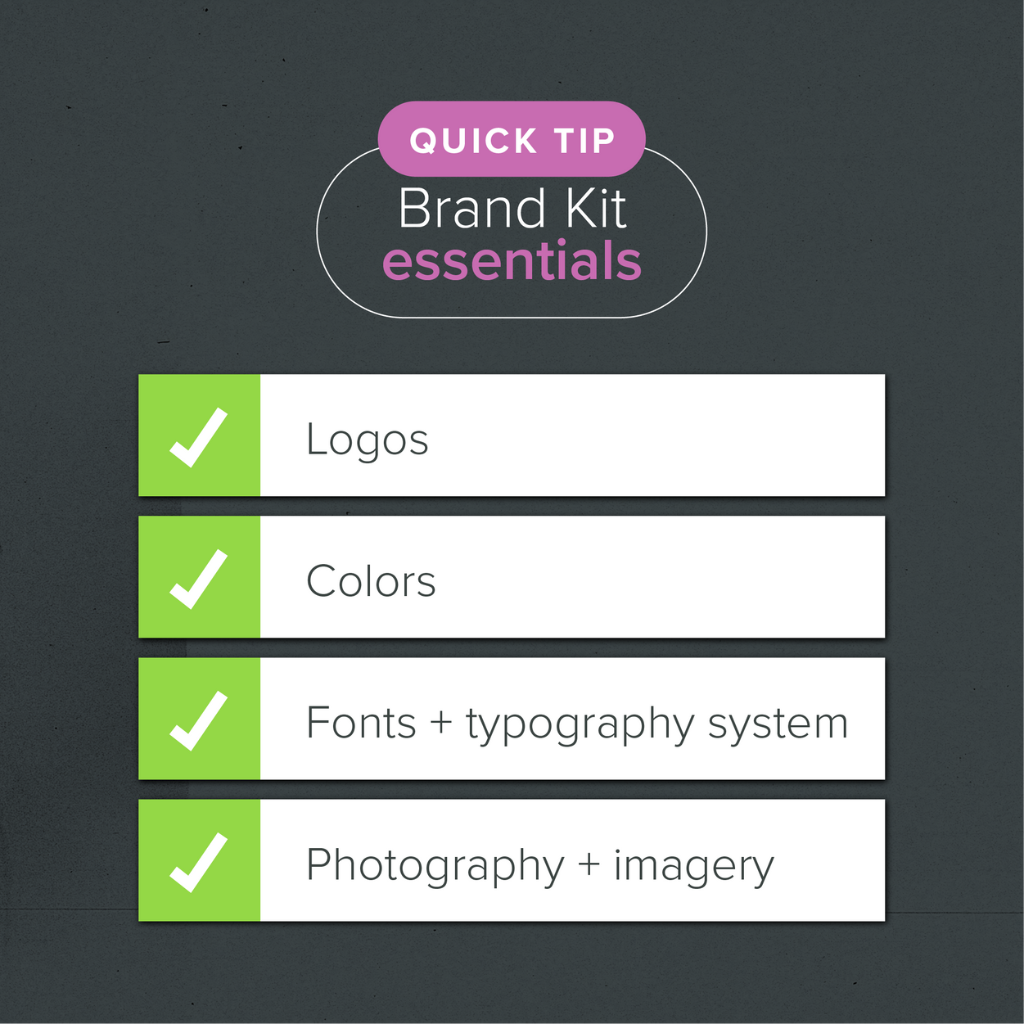Your company is so much more than a building.
In the same way, your brand is so much more than a logo. If you want your business to reach its full potential, you need a complete and consistent branding kit.
In this article, we’ll explore branding kits in-depth: what they include, why they’re important, and the immense value they bring to the child care centers that implement them effectively.
What’s the Goal of a Branding Kit?
A branding kit helps your business align its visuals with its values to clarify your identity for your audience.
Essentially, the goal of a branding kit is consistency. You need a consistent brand image across every product, service, and customer interaction so that both prospects and clients know what to expect from your business.
A consistent appearance and experience informs prospects of the quality and value of your service — they know what you’re all about before they’ve even scheduled a tour.
Achieving this is the hallmark of both a successful franchise (take a brand like Walgreens or CVS, for example: no matter what location you walk into, everything looks the same) and a successful single-location business.
Much of your brand image relates to the feeling people experience when they interact with your brand. It could be joy, reassurance, peace of mind, delight, or excitement. Whatever it is, it should be consistent throughout your brand.

What Is a Branding Kit and Its Components?
A branding kit is a standardized, comprehensive guide to who or what your brand is, and how to communicate that to maintain brand consistency.
It includes four essential components, each of which contributes to the overall brand image of your business:
Logos
While most business owners assume they only need one logo, the fact is every business needs several. Different situations require different icons and logos featuring various colors, sizes, and other modifications while still maintaining consistency.
When we make branding kits for our clients, we always include multiple variations, including horizontal and vertical versions, as well as text-only and icon-only versions. We try to cover any and all uses.
Why Logos Matter
Your logos are snapshots of your brand. They act as a nametag and should communicate the feeling of your business. For the right audience, they should give an engaging first impression.
Although important, logos aren’t the end all, be all. The rest of the branding kit is just as crucial. Your logo is your nametag, but a nametag can’t tell your whole story.
However, your logo is a great opportunity to use symbolism to represent your company’s values. Subtly convey what matters to you and what your business is all about, and be sure to set rules for how (and how not) to use your logo properly.
Colors
Sometimes color can communicate your vibe even better than a logo. Colors are deeply emotional on a subconscious level. They have different schemas and meanings you may not even realize you’re accessing when you use them. For example, red and yellow trigger hunger, which is why so many fast food chains use those colors.
Shades of colors also matter a great deal. Bright blue and green evoke very different feelings than pastel blue and green.
Just as important as the emotional consequences of color choices are the practical consequences. Will a color be legible on white paper? Will it work aesthetically with other elements in your brand design?
Finally, understand that colors are often symbolic — they can represent luxury, value, eco-friendliness, etc. Be sure the colors you choose work in harmony with other brand elements and imagery you’ve selected, as well as your brand image overall.
Standardizing Your Colors
In a branding kit, colors are standardized and listed systematically. Business owners need a different set of color codes for different projects to make sure colors come out perfect and accurate every time. A single shade of blue, for example, will have a different code for a digital application than it will for a print application and a web application.
The color code systems and their corresponding mediums are as follows:
- RGB — digital
- Pantone — print
- CMYK — print
- Hex — web
Your branding kit should also include a primary palette for everyday use and a secondary palette for different use cases, along with codes and different shades of every color. For example, dark blue and light blue, dark green and light green, dark pink and light pink, etc.
Fonts and Typography
Your company’s fonts convey a personality that should represent your brand. Fonts communicate your company’s level of professionalism, quality, and trendiness — how traditional or modern you are — and your company’s level of femininity or masculinity.
If your logo is your name tag and your colors are your clothes, your fonts are your personality. They’re how your company speaks to its audience, and they create a visual hierarchy of information for the reader.
Standardizing Fonts and Typography
First and foremost, fonts need to be standardized. Most brands should stick to two different fonts. We never recommend using more than three — four or more fonts will appear cluttered.
Your branding kit will include variations and sizes for each use case, such as headings (H2, H3, etc.) and body to help readers automatically sense the hierarchy of information. To choose the right fonts for your brand, you need a strong understanding of your target audience. In child care, this tends to be professional but not rigid, and leans toward feminine without being “girly.”
You can take inspiration from brands your target audience loves and trusts. If you hang up ads from those brands next to your own brand material, they should look like they live in the same world.
Photography and Imagery
Finally, a complete branding kit will include photography and imagery guidelines. These provide a set of rules for how to choose visuals that align with your values, and how to tell if a stock photo is out of place or fits with the rest of your brand image.
This is where aligning your brand’s values and visuals becomes crystal clear.
It’s All About the Details
The images you choose to represent your brand need to evoke the same cohesive feeling as the rest of your brand. The key to this is in the details.
Will your images be moody, or will they be light and bright? If you use photos of children, what ages will you represent? Will you show their faces?
The specifics of what you will and won’t use in your images are just another way your clients will come to define your brand.
The Complete Branding Kit: A Solid Foundation
Branding is the foundation of your business. You have to have a solid foundation in place before you move on to anything else, because your branding impacts how you do everything else. Your marketing strategy, web copy and design, and ad campaigns all depend on your branding.
That’s why, when our clients tell us they have an incomplete branding kit or no branding kit at all, branding is the very first place we start. Once we get our clients set up with a great branding kit that meets their needs, we can move forward with other goals, like digital marketing strategy.
If you don’t have a complete branding kit but would like to start one, let’s talk! We’re here to help!
Subscribe
Sign up with your email address to receive news and updates.

